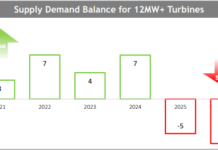John Petersen
Last week I had the pleasure of participating as a panelist in Infocast’s Storage Week and attending four days of presentations by industry executives, national thought leaders and policymakers. While most of the presentations were too detailed and specific for a blog about energy storage stocks, there were a few high-level discussions that may be interesting to readers and while I’ll never qualify as a journalist I can at least share some of the thoughts I jotted down.
Storage for Integration of Renewables
Two of the most important presentations came from Dr. Imre Gyuk, the DOE’s Program Manager for Energy Storage Research, who explained that the unbuffered grid is vulnerable to collapse, noted that power outages cost American business an estimated $79 billion per year in lost productivity, and described grid-based energy storage as “a disruptive technology that will induce a paradigm shift in the utility industry.” He further explained that storage has become a national priority as an integral subset of the smart grid program because of the multiple benefit streams it offers utilities in the form of frequency regulation, peak shaving, energy management, and transmission and distribution system upgrade deferral.
In his presentation, Dr. Gyuk specifically asked participants to support S. 1091, the Wyden Bill, which will provide a 20% investment tax credit for grid connected storage facilities that have at least 2 MW of capacity and can deliver 500 kWh for a period of 4 hours; makes utility-owned storage facilities eligible for clean renewable energy bonds; and provides a 30% investment tax credit for residential energy storage equipment. When the new subsidies are coupled with existing provisions that provide investment tax credits for storage system manufacturing facilities; ultra-rapid depreciation on eligible projects; and a short-term program that will offer cash subsidies to renewable energy storage projects in lieu of tax credits, the potential impact is massive.
In his discussion of the challenges associated with integrating intermittent renewables into the power grid, Dr. Gyuk explained that the peak-efficiency hours for both wind and solar do not mesh well with periods of peak demand for electric power. In the case of wind, the peak efficiency is usually at night when customer demand is lowest. In the case of solar, peak efficiency is usually around noon. Since peak demand typically occurs at about 4 P.M., Dr. Gyuk explained that short-term storage to shift power availability from off-peak to peak hours significantly increases both the usefulness of intermittent power sources to utilities and the economic returns to owners of those generating assets.
Community Energy Storage
Another important presentation came from Ali Nourai, AEP’s manager of distributed energy resources who provided an overview of AEP’s new Community Energy Storage (CES) program. In discussing the CES program, Dr. Nourai explained that the concept is “technology neutral” and emphasized that system reliability and “commodity priced batteries” would be critical drivers. He also noted that if PHEVs and EVs follow their expected development path, the batteries used in CES installations would likely be the same batteries used for automotive applications because widespread adoption in the auto industry would drive battery prices down to a level where they would likely be attractive to utilities. The key factors that Dr. Nourai stressed as critical for the CES program were:
- Improved safety and security;
- Increased customer reliability and value;
- Optimized realization of multiple value streams;
- Simplified integration of distributed power generation;
- Simplified budgeting for smaller neighborhood projects; and
- Simplified purchasing decisions by lower-level personnel.
Since the CES proposal contemplates installing batteries in a standard sized transformer box  and assumes that Li-ion batteries will become a dominant technology for PHEVs and EVs, it clearly gives a short-term advantage to Li-ion battery developers who can make products that will fit in a limited volume. I remain skeptical about whether Li-ion battery technology will ever be robust enough or cheap enough for widespread adoption in the automotive industry and I wouldn’t be surprised to see the volume constraints relaxed over time to facilitate the substitution of flow batteries and advanced lead-acid batteries. Seriously, does anyone really care whether the ugly green box hiding behind the shrubs is 3′ by 3′ instead of 4′ by 4′? For the time being, the CES program favors Li-ion technology by imposing size constraints that have nothing to do with performance. It will be interesting to see how the program evolves as the cost and performance profiles for various battery technologies become clearer.
and assumes that Li-ion batteries will become a dominant technology for PHEVs and EVs, it clearly gives a short-term advantage to Li-ion battery developers who can make products that will fit in a limited volume. I remain skeptical about whether Li-ion battery technology will ever be robust enough or cheap enough for widespread adoption in the automotive industry and I wouldn’t be surprised to see the volume constraints relaxed over time to facilitate the substitution of flow batteries and advanced lead-acid batteries. Seriously, does anyone really care whether the ugly green box hiding behind the shrubs is 3′ by 3′ instead of 4′ by 4′? For the time being, the CES program favors Li-ion technology by imposing size constraints that have nothing to do with performance. It will be interesting to see how the program evolves as the cost and performance profiles for various battery technologies become clearer.
Energy Storage Heretic
On the third day I had an opportunity to play devil’s advocate during a presentation by Mark Peters, the Deputy Associate Laboratory Director for the Li-ion battery development program at Argonne National Laboratories. During the question and answer session, I explained that for several months I’ve been suggesting that the inflection point for Li-ion batteries seems to be when you put a plug on a car because until you get to an all-electric drive train, the weight and volume differences don’t justify the additional cost. Mr. Peter’s response came as a pleasant surprise to me because he basically said “While there are members of my staff who would probably disagree with you, I tend to personally believe that your assessment is reasonable and the sweet spot for Li-ion batteries arrives when you add a plug.”
By the afternoon of the fourth day, I had lapsed into full heretic mode for a panel discussion on the future of vehicle to grid technology. I think it came as a bit of a shock when I said “I don’t believe V2G will happen because I don’t believe PHEVs and EVs will happen in anything that even remotely resembles current plans.” I then laid out the simple case against PHEVs and EVs as follows:
- The principal goal of the smart grid is the minimization of waste in the electric power industry;
- The most wasteful activity I personally engage in is using gasoline to power 4,000 pounds of car and 300 pounds of passengers at highway speed;
- The only activity I can imagine that would be more wasteful is using batteries to power 4,000 pounds
of car and 300 pounds of passengers at highway speed; - While most of the conference participants can afford the $40,000 cost of an eco-bling PHEV or EV, that option is not available to over 90% of the car buying public who need to worry about things like budgets and car payments;
- There are 6 billion people who live in crushing poverty and for the first time in history most of them understand that there is more to life than subsistence farming;
- As the 6 billion become consumers, our biggest challenges will be finding relevant scale solutions to shortages of water, food, energy and virtually every commodity you can imagine;
- Last year 23 million electric bikes and scooters were sold in China and those E2Ws used the same battery capacity that one million American style PHEVs would have required;
- From the perspective of a foreign government planner, providing mobility for a million wasteful Americans is not as important as providing mobility for 23 million locals who have more reasonable demands and aspirations; and
- From the perspective of raw economics, a purchaser who needs a small battery pack can afford to pay a higher price per watt-hour than a purchaser who needs a large battery pack, which will leave PHEVs, EVs and grid-connected applications at the bottom of the food chain rather than at the top.
I wonder if they’ll invite me back as a panelist for next year’s conference.







